Starting November 1, 2024, all service conversations are free for businesses! Free session conversations are now unlimited. This update allow you to still connected with your customers without worrying about extra costs. For more information, click here.
WhatsApp Pricing Model 2025
Meta has released a schedule for price updates gradually, and we will adjust the price changes in accordance with Meta policy. Information regarding the price update schedule can be found here.
This update will change the Conversation-based Pricing model to a Per-message Pricing model. In this Per-message Pricing model, businesses will be charged based on the number of messages sent according to the message template category, such as marketing templates, authentication templates, or utility templates. This Per-message Pricing model will be implemented starting on July 1, 2025.
Pre-message Pricing (PMP)
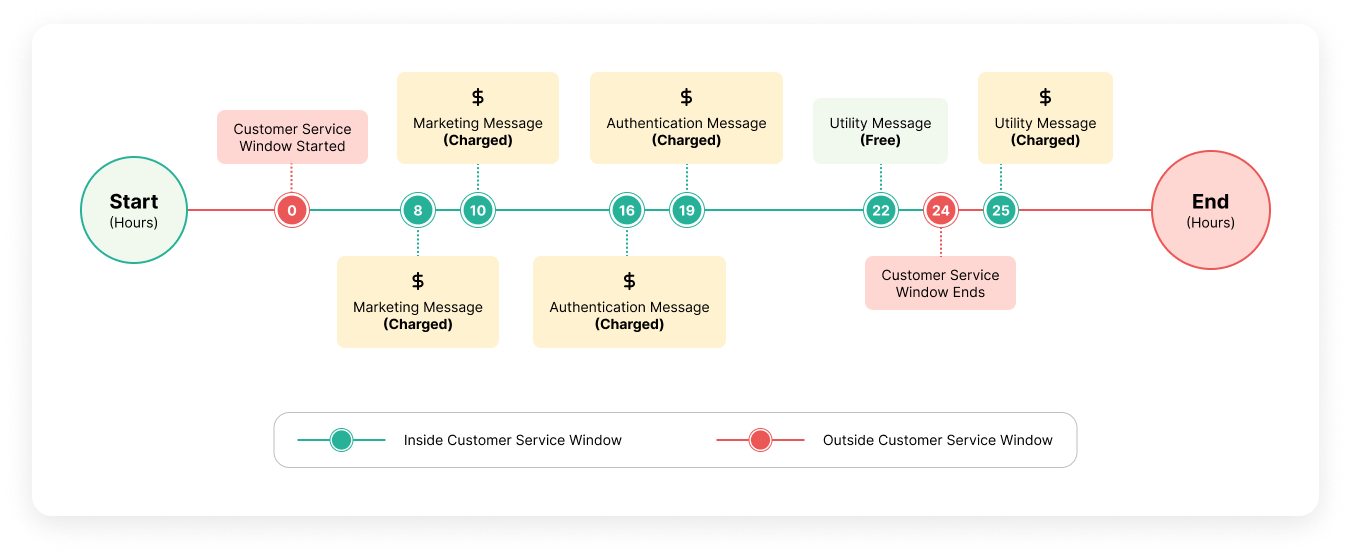
With the Per-message Pricing model, businesses will be charged for each template message successfully delivered to users. Below are the details of the new model's terms:
- Marketing Template Messages: Charges apply for every marketing template message successfully delivered to customers.
- Authentication Template Messages: Charges apply for every authentication template message successfully delivered to customers.
- Utility Template Messages: Charges apply for every utility template message delivered outside the customer service window.
Example:
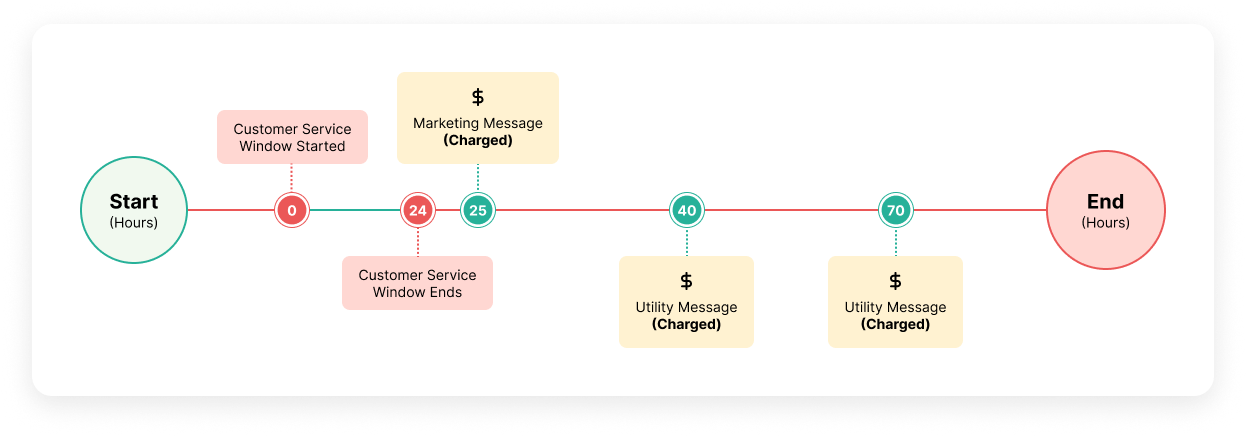
If you send 1 marketing template message and 2 utility template messages outside the customer service window, you will be charged for 3 messages (1 marketing, 2 utility).
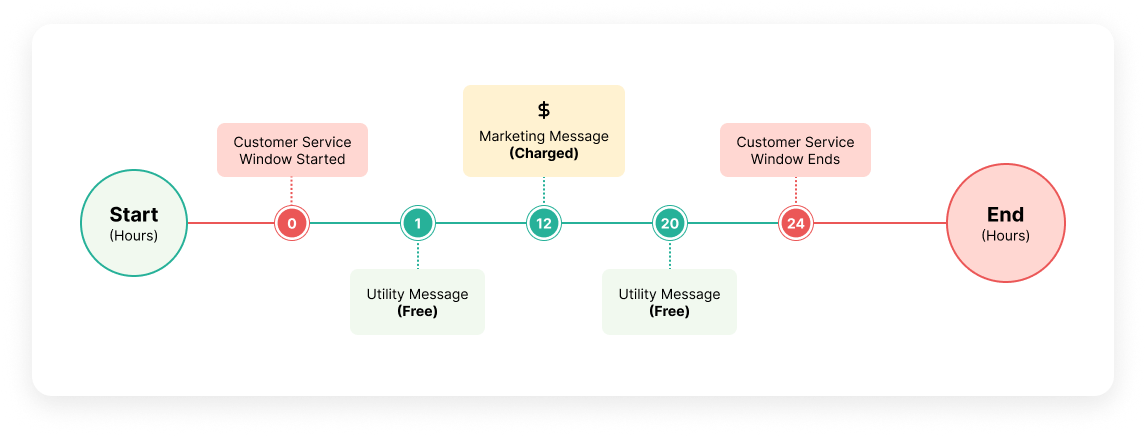
However, if 2 utility template messages are sent within an open customer service window between the business and the user, only 1 charge will apply for the marketing message.
Free Entry Point Conversations
With the introduction of per-message pricing, free entry point conversations now operate based on messages rather than conversations. If a WhatsApp user sends you a message through a free entry point (such as a WhatsApp Ad), you can respond with any type of message for free within 24 hours. This response activates a 72-hour Free Entry Point Customer Service Window. During this window, you can send messages of any type to the user at no cost.
Example:
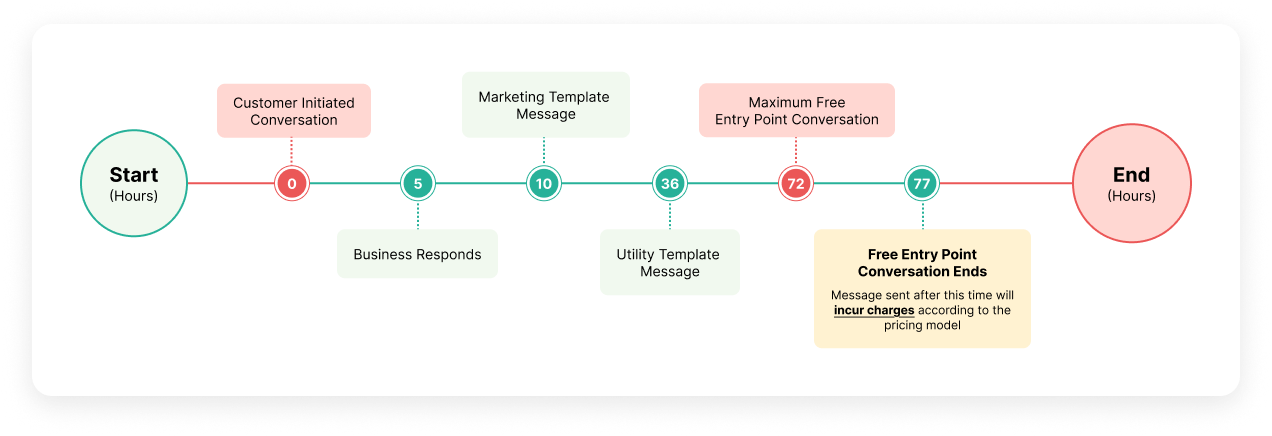
- Hour 0: A customer sends a message to a business via a Click-to-WhatsApp Ad. (This initiates a free entry-point conversation.)
- Hour 5: The business responds with a free text message. (No charge; this opens a 72-hour Free Entry Point Customer Service Window.)
- Hour 10: The business follows up by sending a marketing template message. (Still no charge; the free entry-point window remains active.)
- Hour 36: The business sends a utility template message. (No charge; the free entry-point window is still open.)
- Hour 77: The free entry-point window ends at Hour 72 . (Messages sent after this time will incur charges according to the pricing model.)
International Authentication Rates
The International Authentication Rates requires businesses to pay different fees when sending authentication messages to customers located outside their primary business location. If a business opens more than 750,000 authentication conversations within a rolling 30-day period across its WhatsApp Business accounts, with WhatsApp users having country codes from countries with international authentication rates, the business will qualify for international authentication rates. This eligibility status is permanent. Once eligible, all authentication conversations opened on or after the start time will be subject to international authentication rates.
Countries with International Authentication Rates
Below is the list of countries classified under the international rate category for authentication conversations on WhatsApp. If your business sends authentication messages to customers with country codes from this list, international authentication rates will apply:
- Indonesia (+62)
- India (+91)
- Egypt (+20)
- Malaysia (+60)
- Nigeria (+234)
- Pakistan (+92)
- Saudi Arabia (+966)
- South Africa (+27)
- United Arab Emirates (+971)
Eligibility
A business becomes eligible for the International Authentication rate if it sends a total of more than 750K authentication messages within a 30-day period. Once eligible, any authentication message sent by the business will be charged under the International Authentication rate.
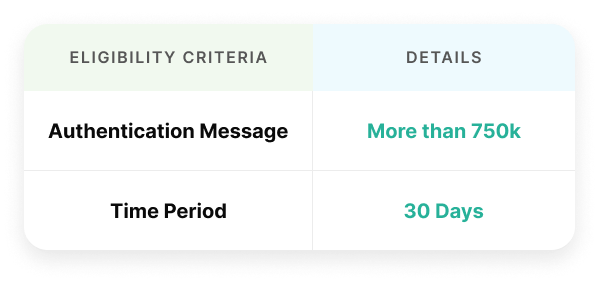
Use Case
- If the business is eligible for International Authentication Rate.

- When the business sends an authentication message to a customer with the country code +62 (Indonesia), they will not be charged the international authentication rate.
- However, when sending a message to a customer with the country code +60 (Malaysia) and +966 (Saudi Arabia) they will be charged the international authentication rate.
- If the business is not eligible for International Authentication Rate.
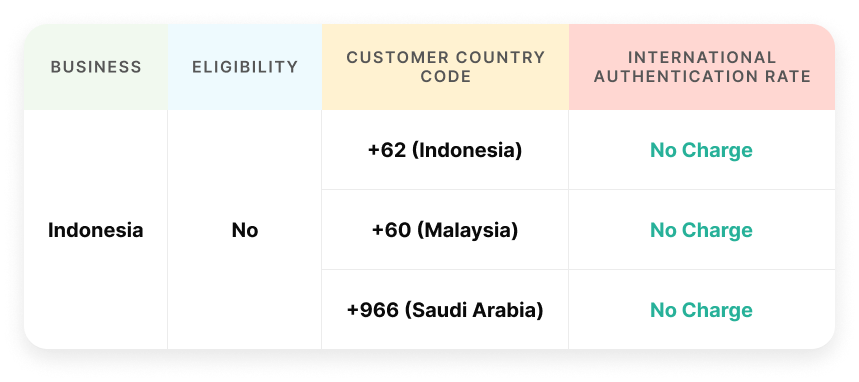
This means the business did not open more than 750K authentication messages within a 30-day period.
- In this case, authentication messages sent to customers with the country code +62 (Indonesia) they will not be charged the international authentication rate.
- Similarly, messages sent to customers with the country code +60 (Malaysia) and +966 (Saudi Arabia) they will not be charged the international authentication rate.
WhatsApp Pricing Model 2023
Conversation Based Pricing (CBP)
WhatsApp officially released the new pricing in 2023 on June 1, 2023. Businesses using the WhatsApp Business Platform will be charged per 24-hour conversation, with different rates by conversation category. Business-initiated conversations will be split into three new categories: utility, authentication, and marketing. Meanwhile, user-initiated conversations will be called service conversations.
Based on the new rates, Marketing conversation rates will be more expensive than Utility and Authentication conversations. You can see the updates to conversation-based pricing here. You can also download the rate cards on the same page for more details about the changes to the new WhatsApp pricing. Related to this change, you can see our rates here.
The difference between current pricing and new Conversation Based Pricing Model 2023
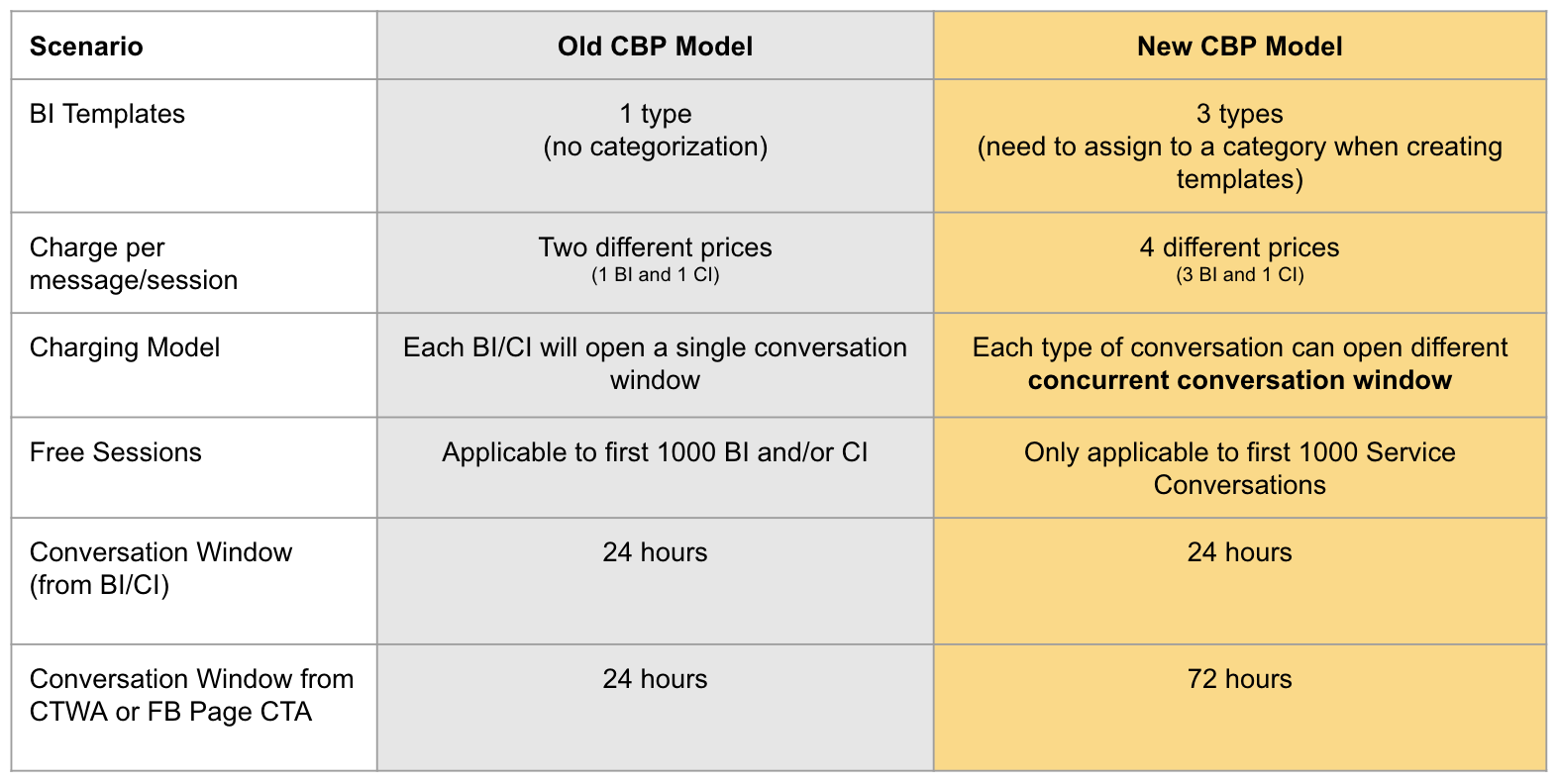
When a customer sends a message to a business, a 24-hour timer called a customer service window begins. During this period, which lasts less than 24 hours since the customer's last message, you can respond with free-form messages. However, if it has been more than 24 hours since the customer's last message, you will be outside the customer service window and must use a message template to send a message. Learn more about customer service window here.
Active Sessions in the Inbox menu
With the implementation of the new Conversation-Based Pricing, WhatsApp introduces the concept of multiple conversation windows. As a result, there can be several active sessions within a single chat room. To view the currently active sessions in a chat room, click the Chat & Customer Info page and select Active Session(s). On this page, you can see a list of all active conversations in the chat room along with the end time of each conversation.
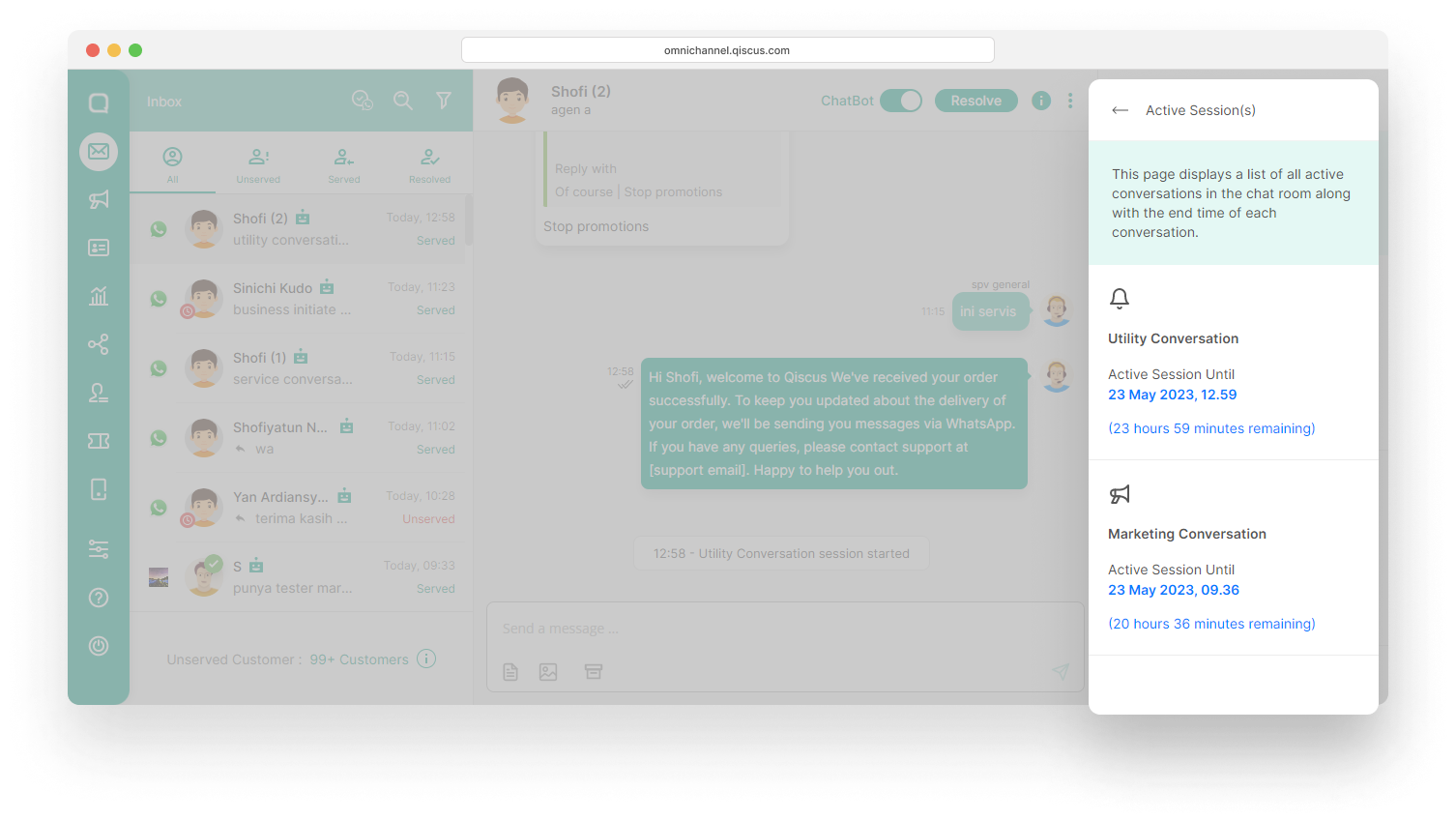
When the session starts from the WhatsApp Ads or Facebook CTA button, businesses can send anything for free for 72 hours.
Sending Broadcast
Due to the new WhatsApp pricing is based on conversation categories, you are required to select a template category first before sending broadcasts via the Outbound Message menu.
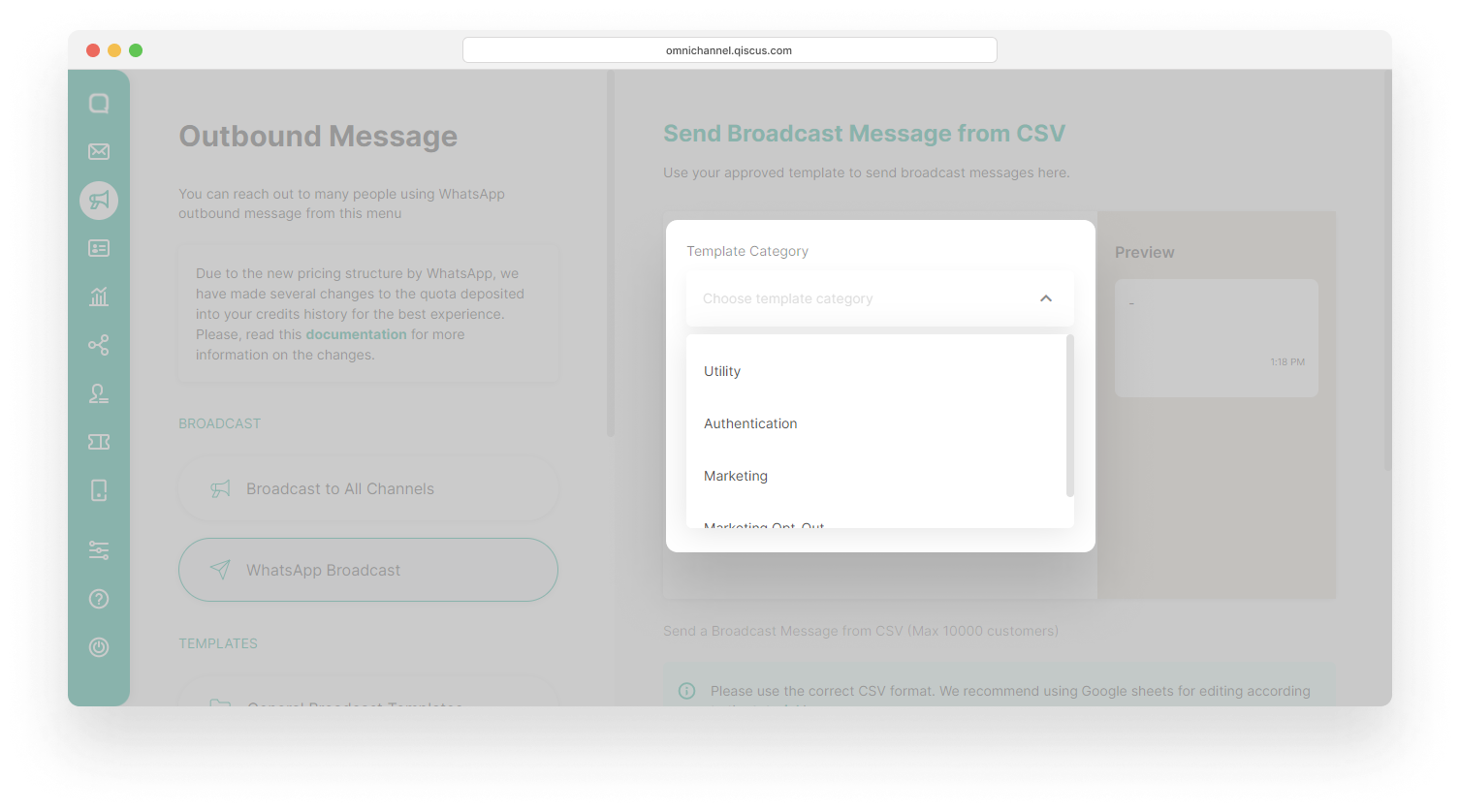
The same thing applies when you are going to send a broadcast via the Inbox menu. You are required to select a template category after selecting a Template Type.
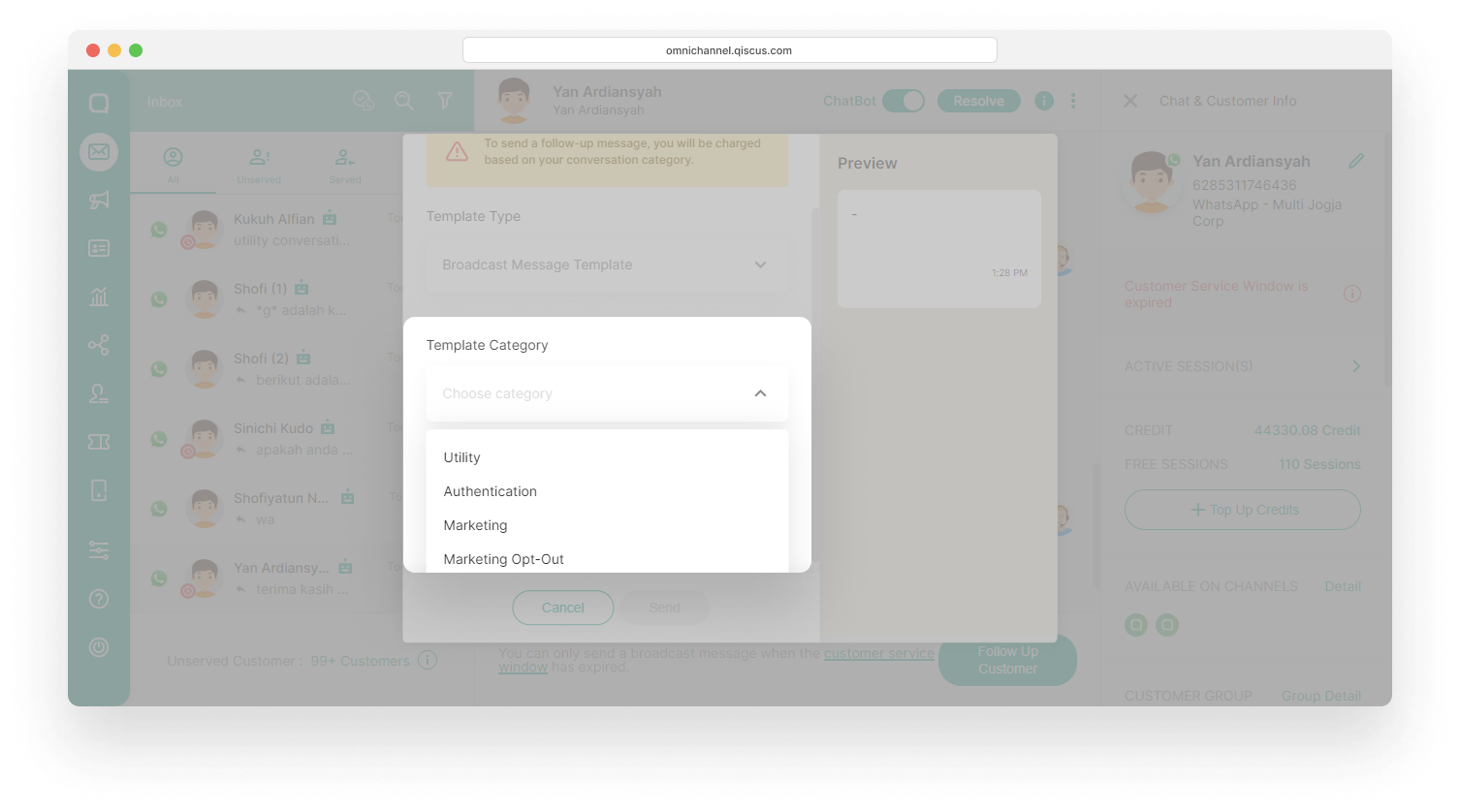
However, if you don't have an approved template for a specific category, you will receive a notification indicating that the category is currently unavailable.

One of the latest features from Qiscus is the button broadcast template, which enables you to send broadcast templates in a chat room when the last customer message was received less than 24 hours ago.
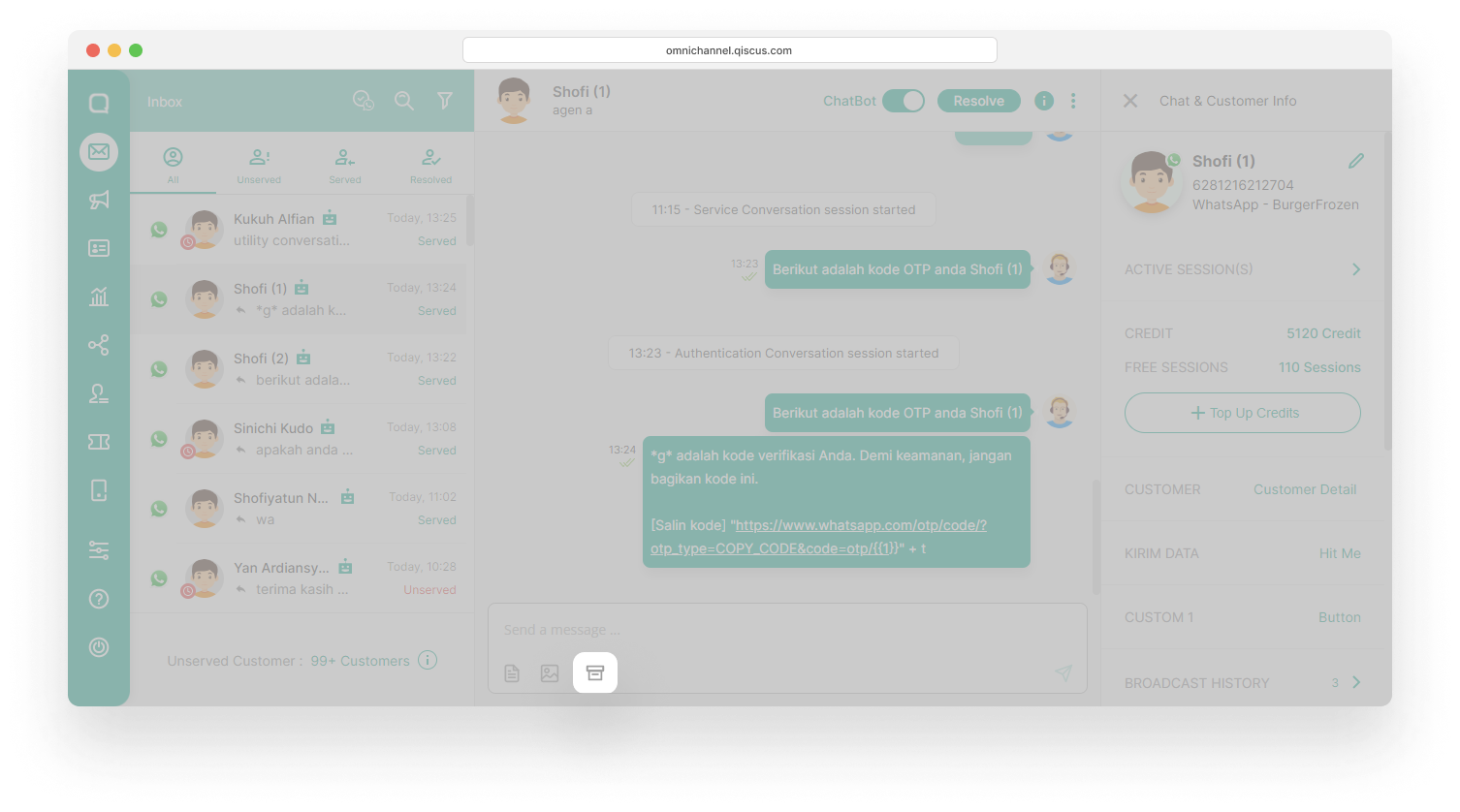
You can choose whether to display this button on the Agents dashboard or not in the following way:
- Go to Setting and select Agents Management,
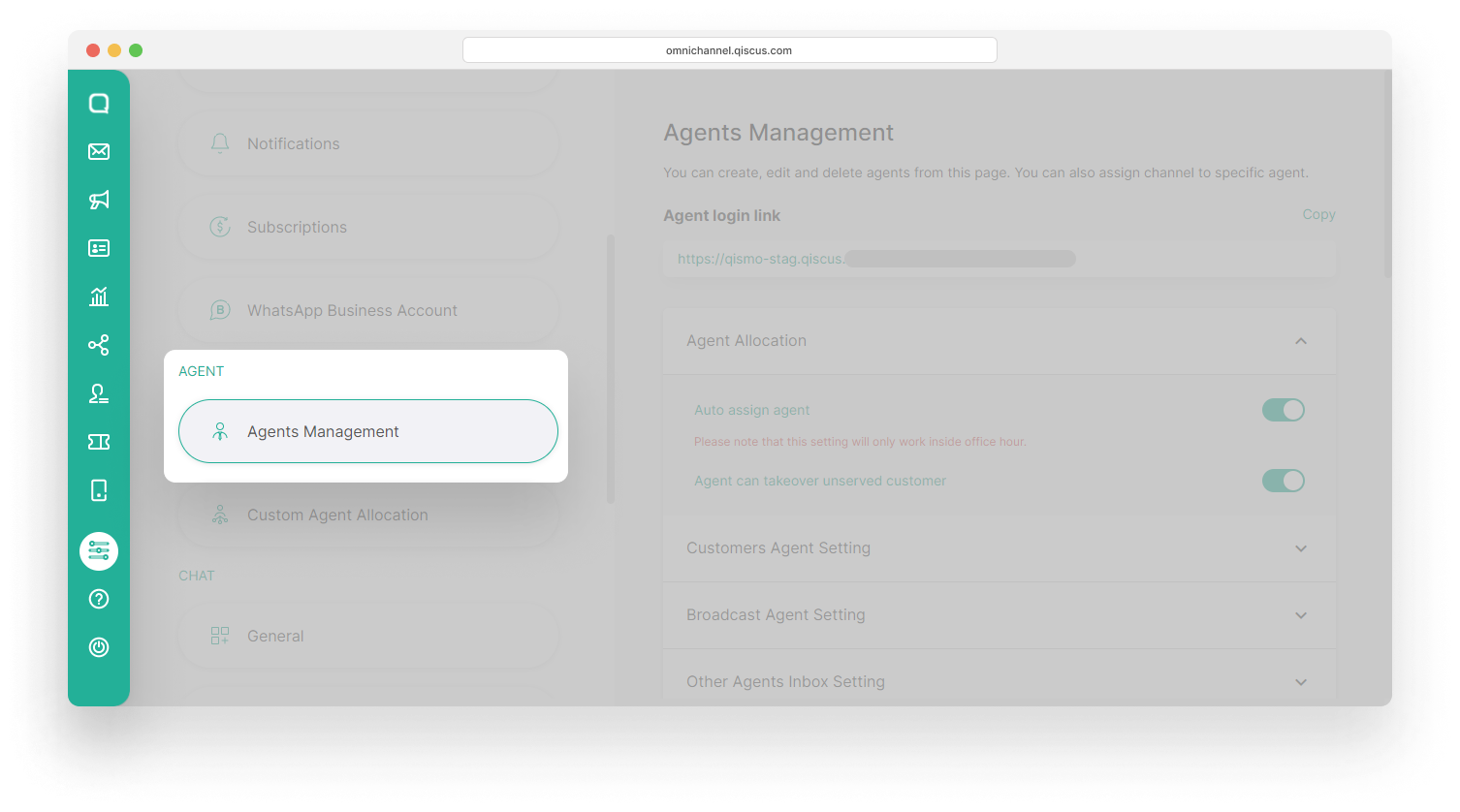
- Select Broadcast Agent Setting and enabled or disabled the Agents can send broadcasts when customer service window is active.
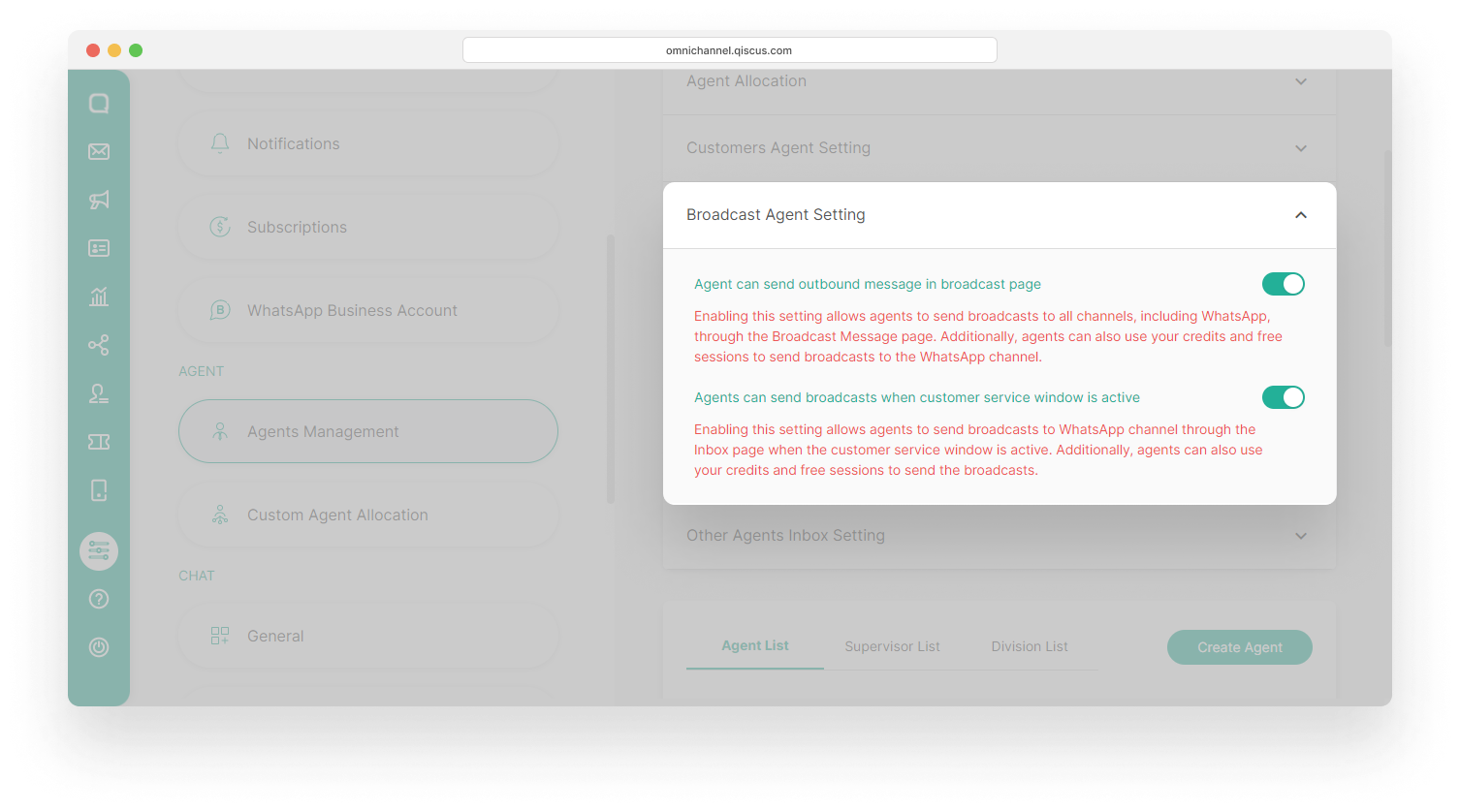
Analytics
The Analytics menu has been updated to provide you with a more convenient way to access your chat history and track the usage of credits and free sessions. To view the changes in the analytics report, you can follow the steps below:
- Go to the Analytics menu and select WhatsApp,
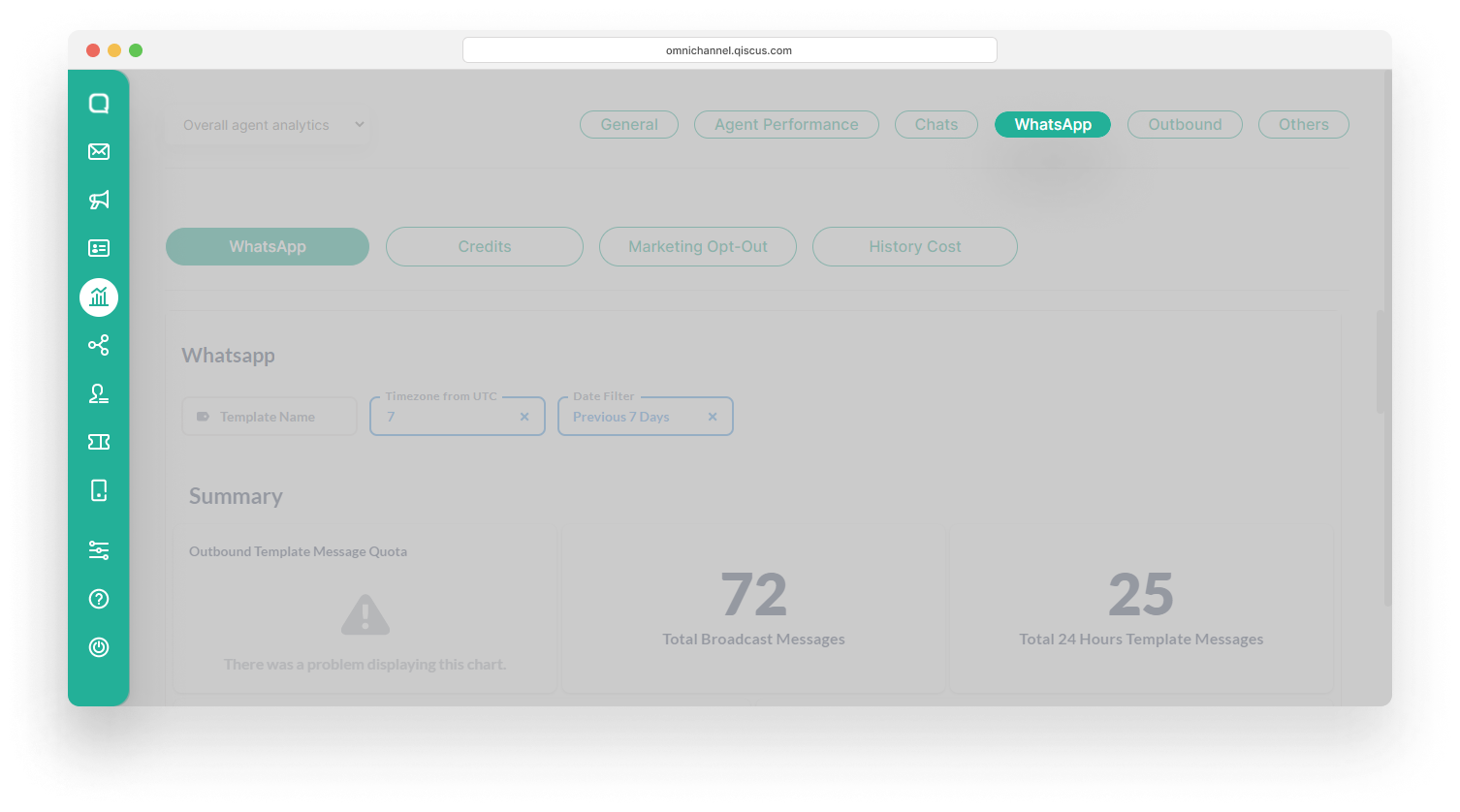
- Select Credits to view the estimated usage of credits for each conversation category,

- Select the channel you want from the dropdown on the right,
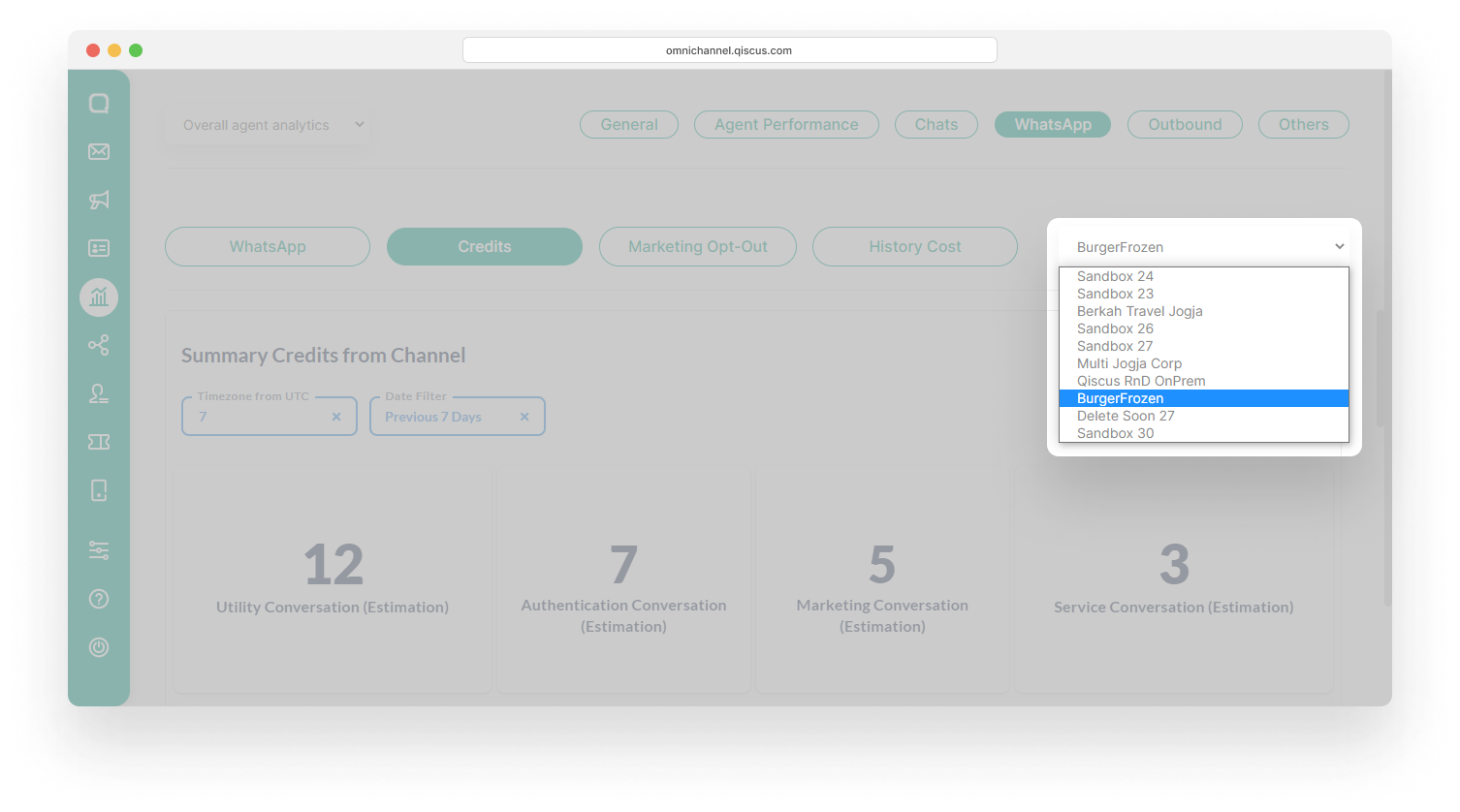
- Select History Cost to track the cost history of credits and free sessions.
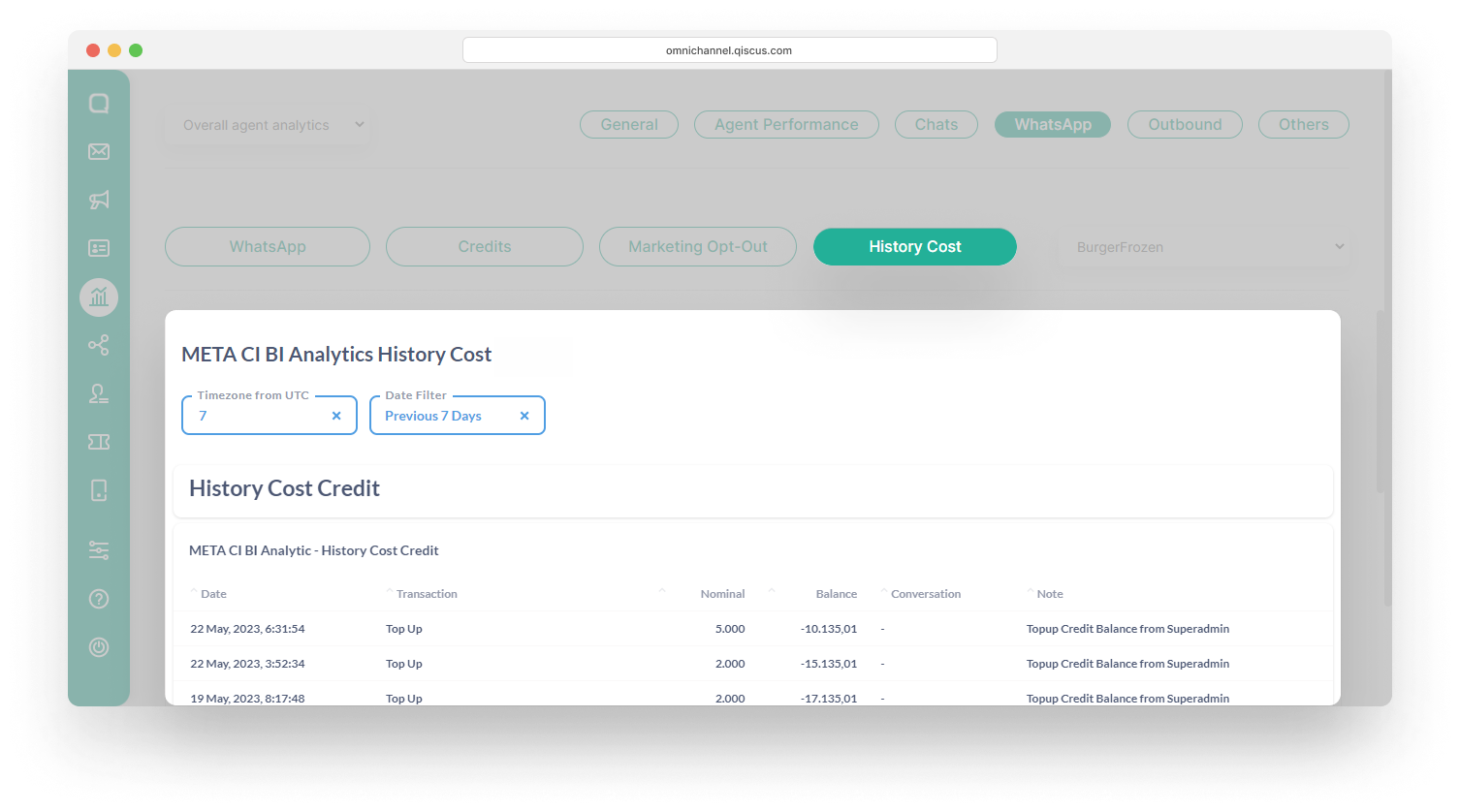
Use Cases
We have created several use cases that can make it easier for you to understand WhatsApp Conversation-Based Pricing.
Use Case 1: Service Conversation Session Started

As you can see in the image above, a Service Conversation session is started when a business replies to a message sent by a customer in less than 24 hours, or when the customer service window is still active. Business cannot reply to customer messages using free form outside the customer service window.
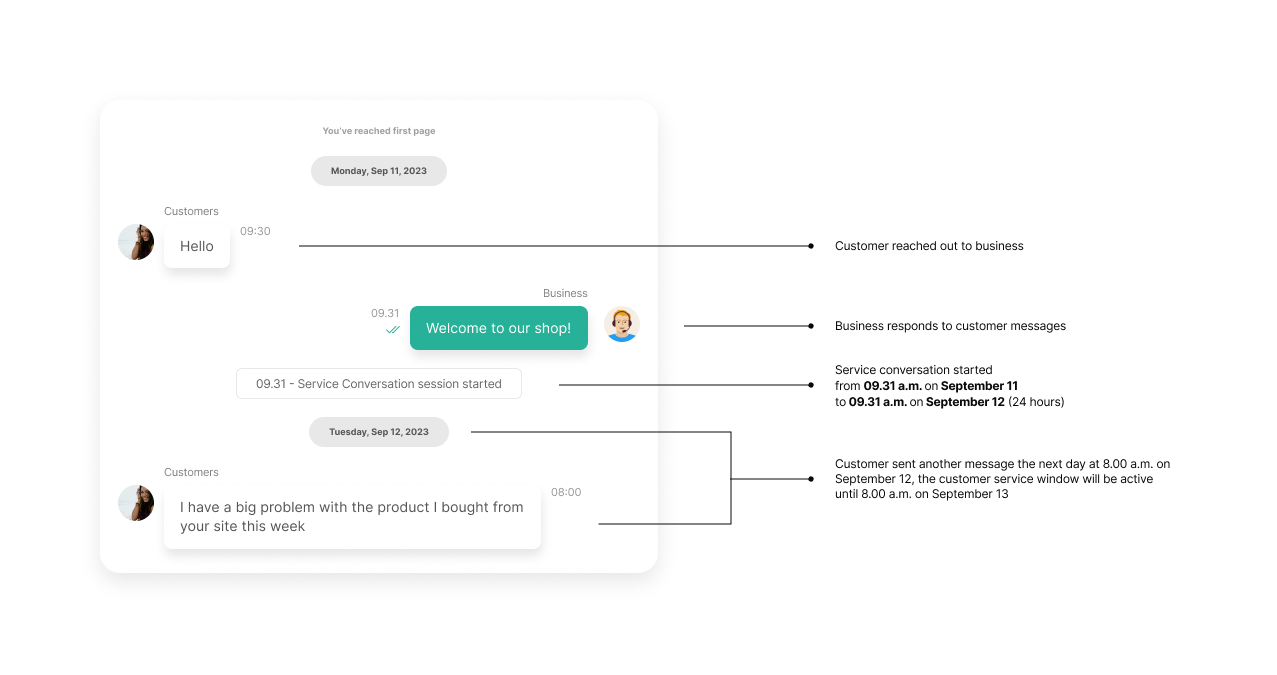
If the customer sends another message while the customer service window is still active, the customer service window period will change according to the time of the customer's last message.
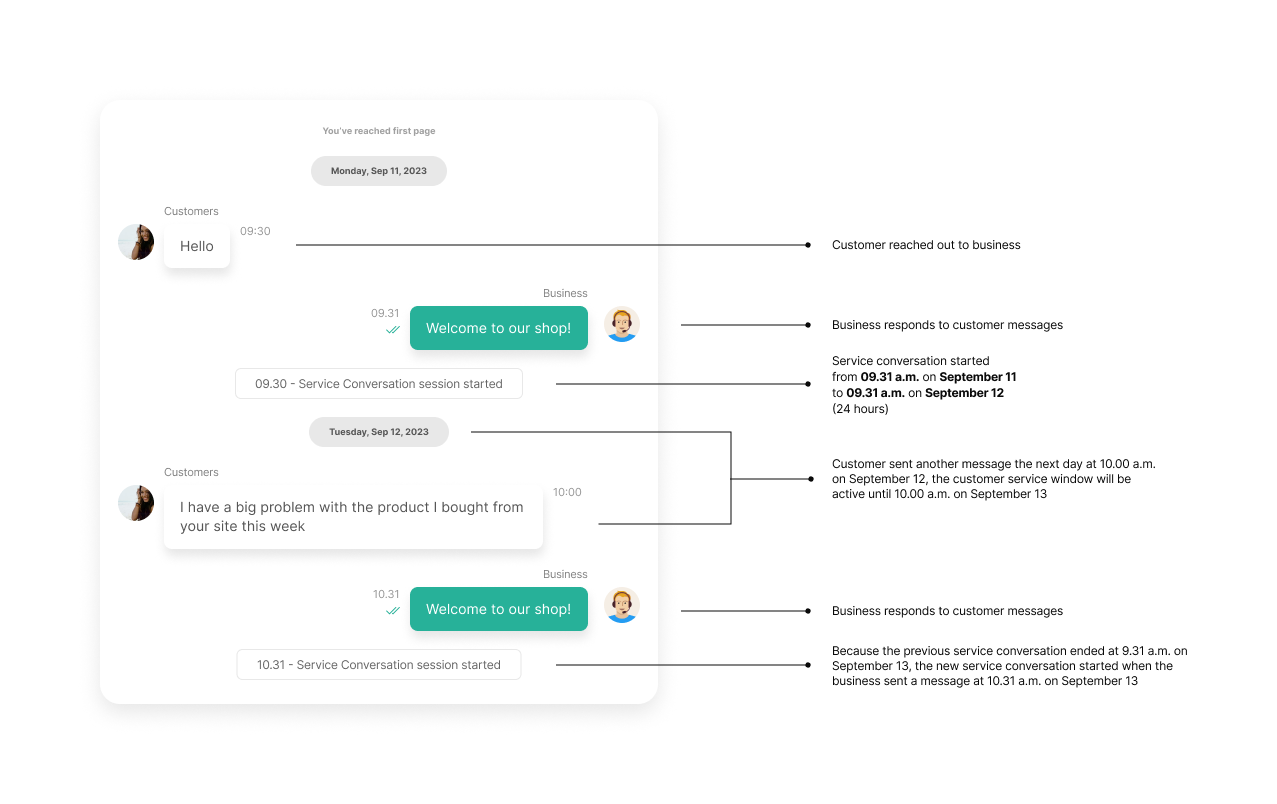
Use Case 2: Click-to-WhatsApp Session Started
Different from other categories, conversations that start from a customer clicking on a CTWA ad have a longer session, 72 hours. During this time, business can respond with any type of WhatsApp message (including marketing templates) for free.
If you do not respond to the CTWA within 24 hours, a CTWA session will not be opened, and the chance to get a free 72 hours will expire. Learn more.
- If you send a category template after the case above, you will be charged based on the category of the template.

Use Case 3: One Business-Initiated Conversation Session Started
In contrast to service conversations and CTWA sessions, business-initiated conversations begin when a business sends a template to a customer. This applies to all categories: utility, Authentication, and marketing. Example for marketing conversation:
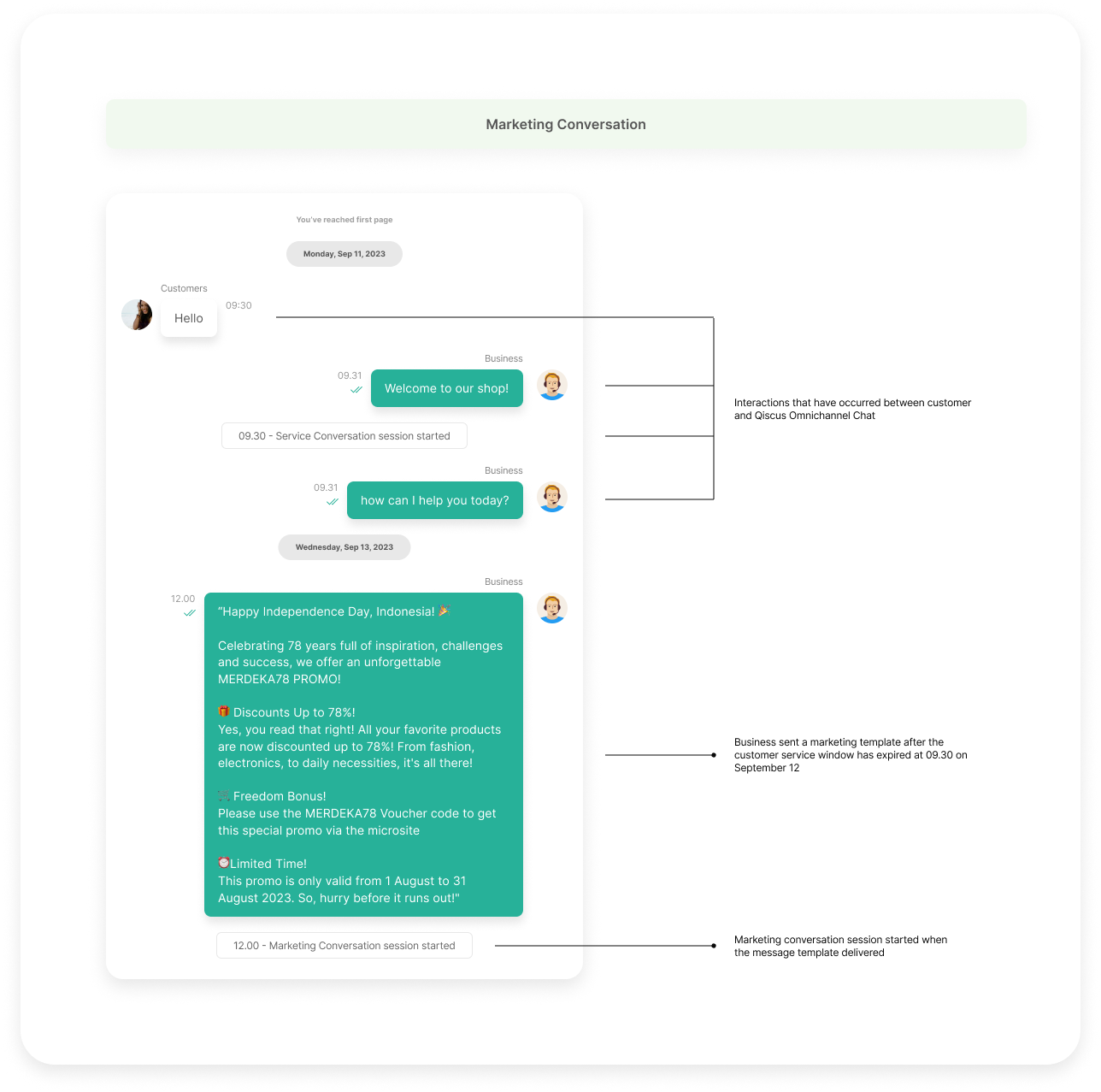
Example for authentication conversation:
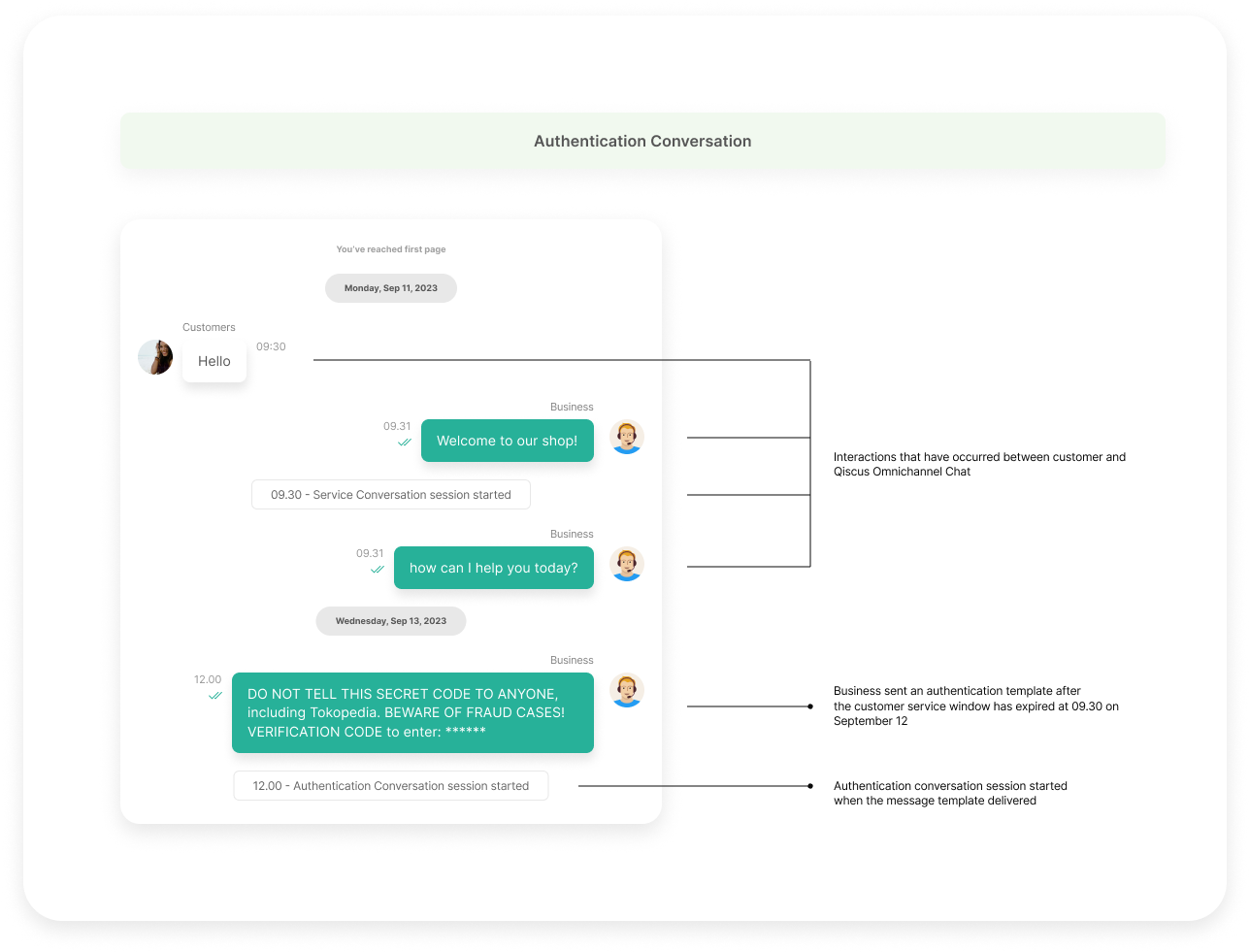
Example for utility conversation:
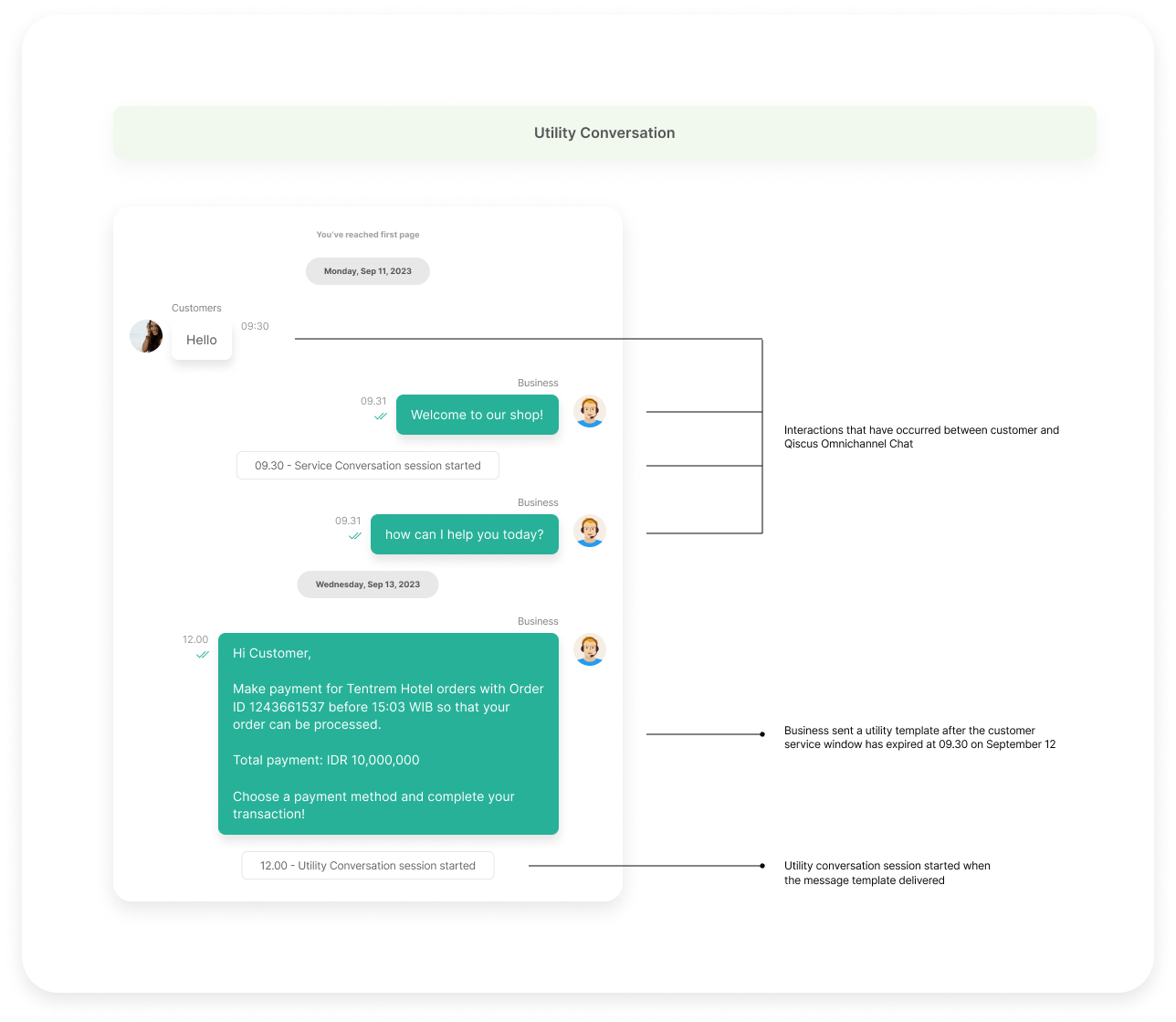
Please keep in mind that if the customer service window is no longer active, you cannot send messages to customers using the free form.
Use Case 4: Send Templates in the Same Category
One session for business-initiated conversation is 24 hours. During this time, you can send more than one message template in the same category without additional fees. For example, if you send a marketing template at 12.00 p.m. on September 12, then you can send another marketing template with a maximum limit of 12.00 p.m. on September 13 or 24 hours after the first template is sent.

Use Case 5: Multiple Conversation Windows
WhatsApp introduces the concept of multiple conversation windows where there can be more than one active conversation. However, if you have an active conversation session but send a message template in another category, you will be charged an additional fee. For example, if you send a marketing template at 12.00 p.m. on September 12, then send an authentication template at 12.05 pm on September 12, you will be charged for the marketing conversation and also the authentication conversation.
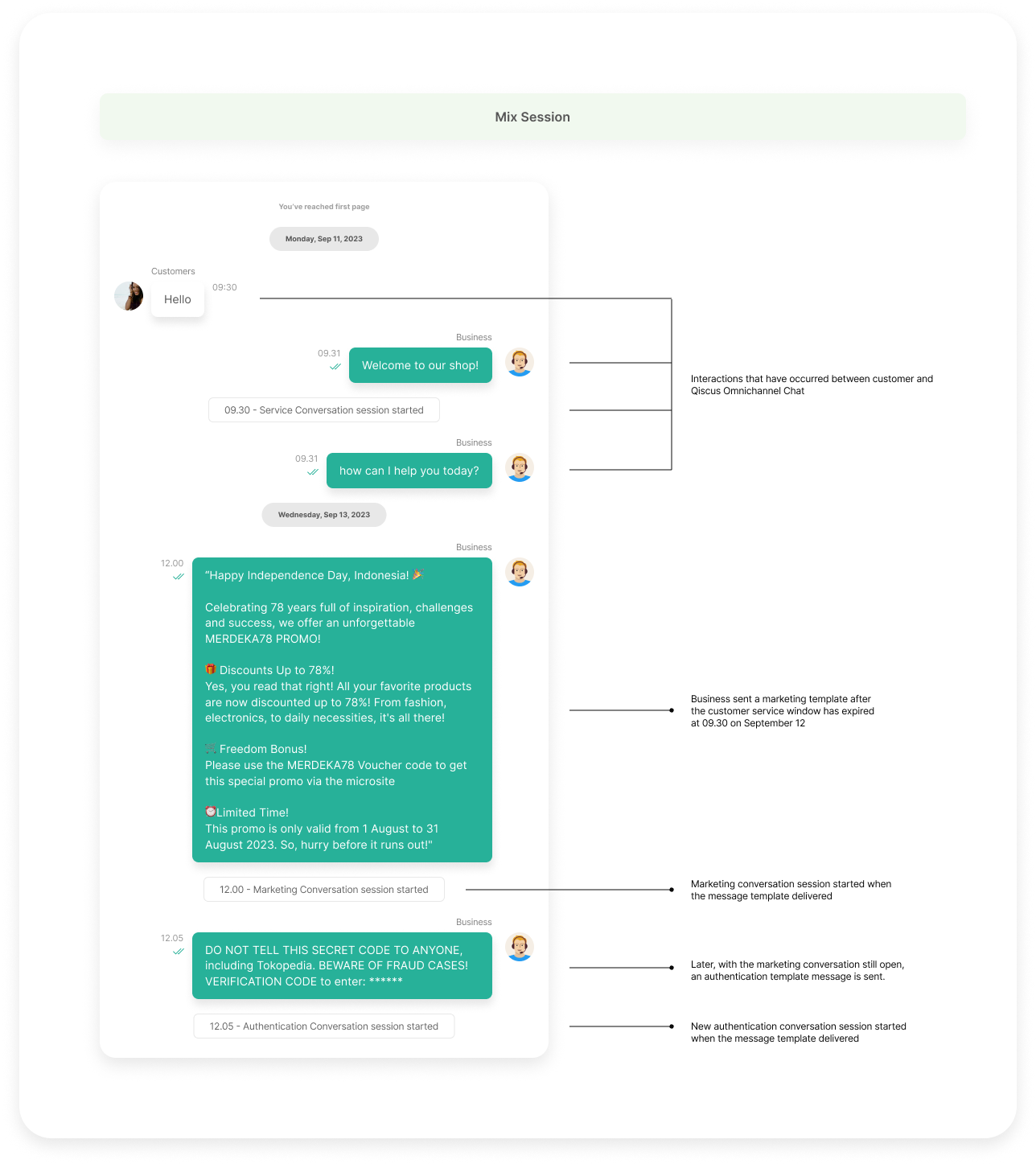
Customer Service Windows vs Service Conversations
- Customer Service Windows
Whenever a customer sends a message to a business, a 24-hour service window opens. During this window, the business can send any type of message, including free-form text, to the customer. However, if the service window is closed, the business is restricted to sending only template messages to the customer.
- Service Conversations
Service conversation refers to customer-initiated messages that happen during the 24-hour service window. These conversations are meant to help with ongoing customer service, such as responding to inquiries or resolving issues.
For the summary, the customer service window is a time frame (24 hours) where the business can communicate freely, while a service conversation is the actual interaction that happens during that window when a customer contacts the business for support.
Example :
H0: A customer sends a message to the business, which opens a 24-hour customer service window.
H2: The business responds with a free-form text message, initiating a service conversation within the open window.
H24: The customer service window ends after 24 hours, and the business is now limited to sending only template messages.
H26: The service conversation has ended, and the business can no longer send any message without opening a new conversation through templates.
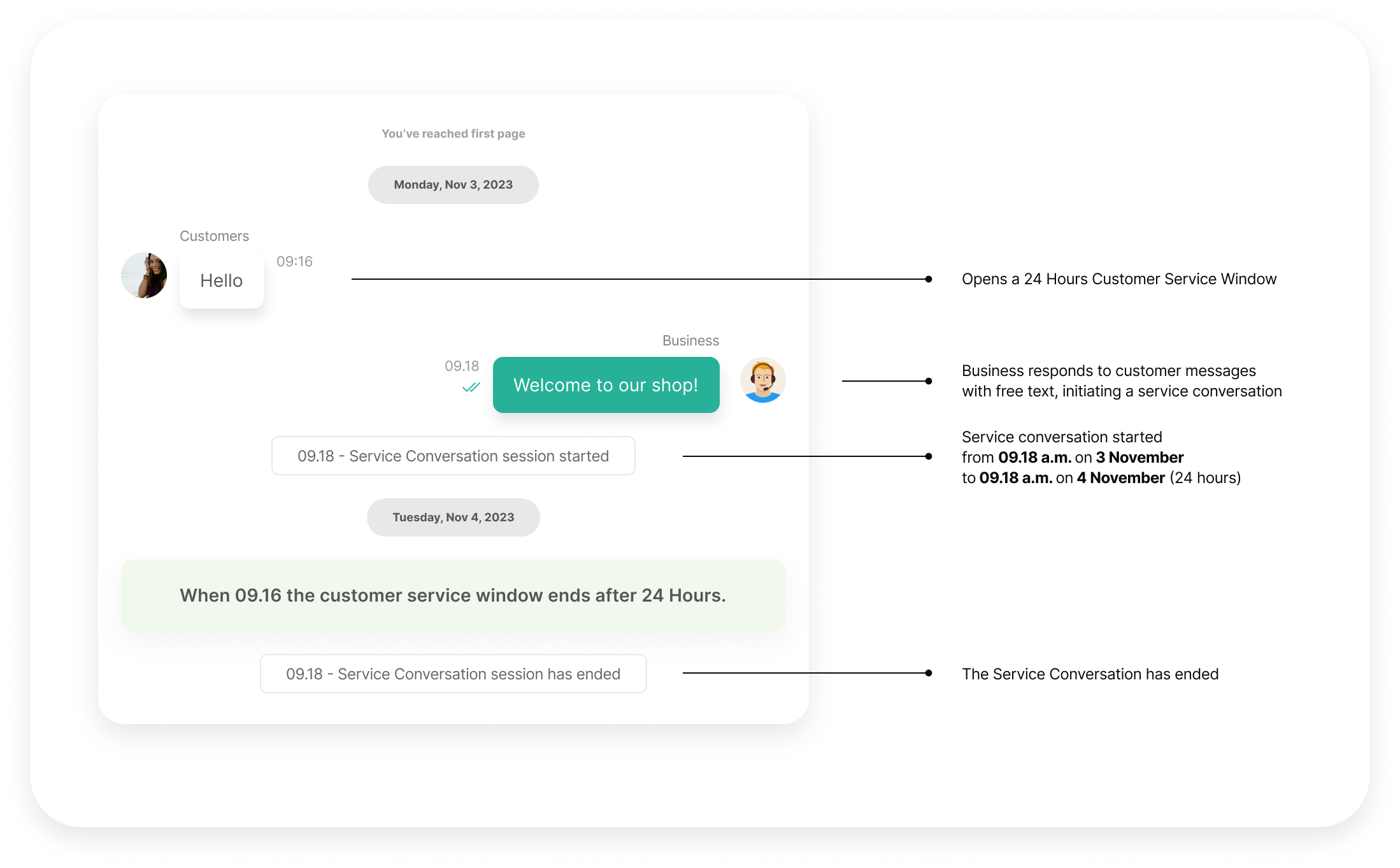
Glossary
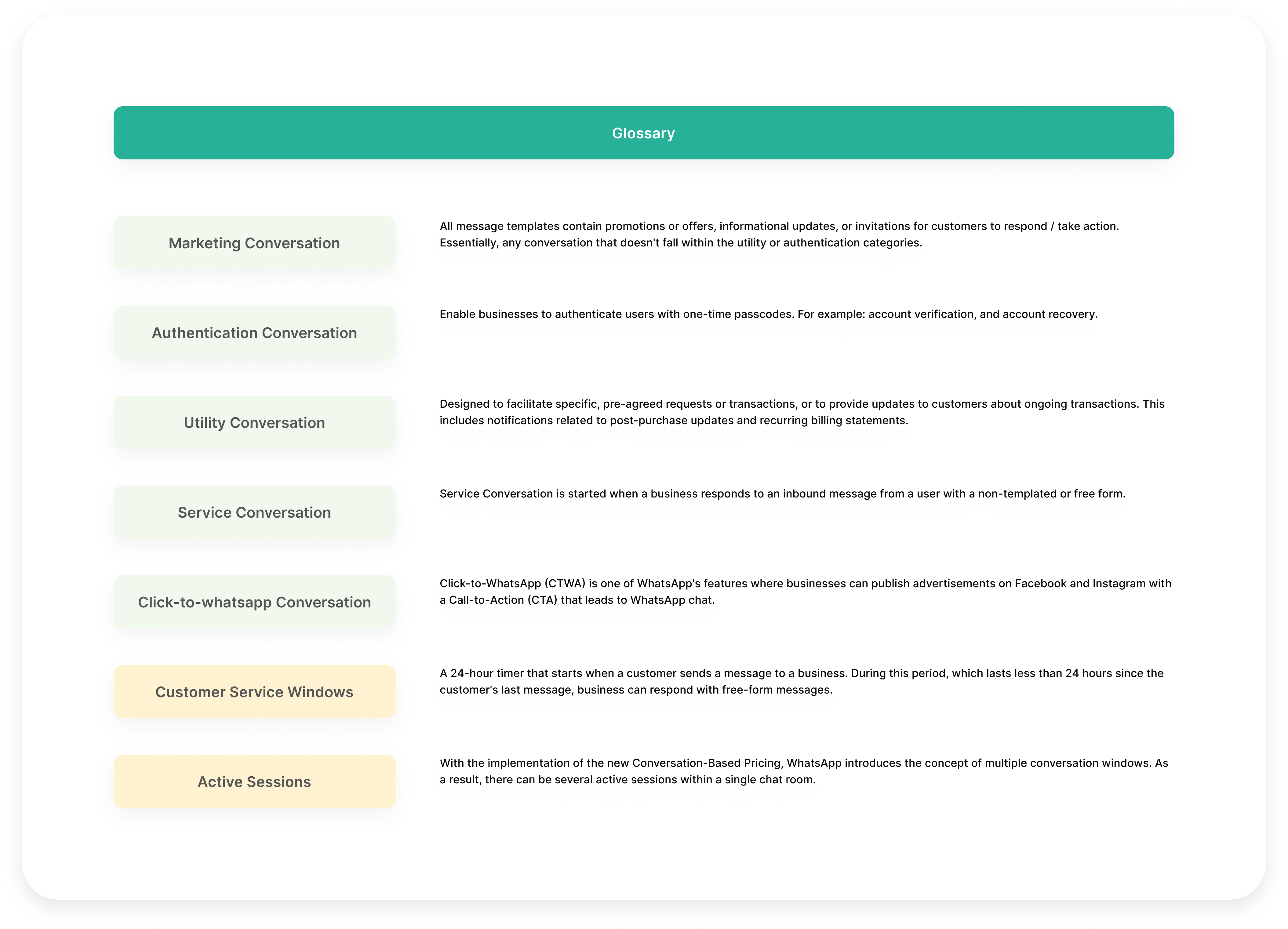
###